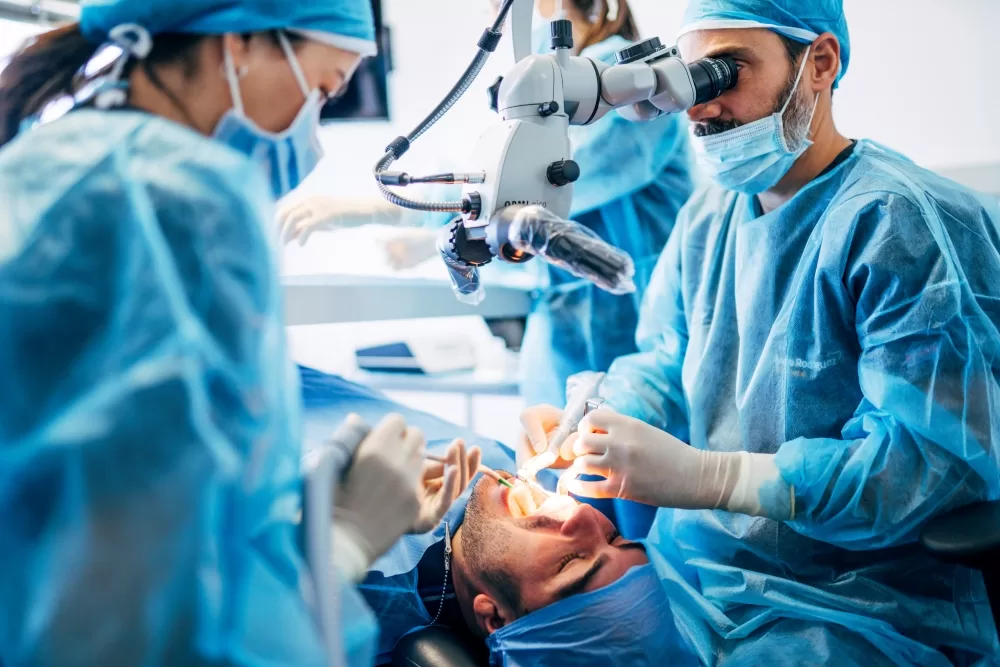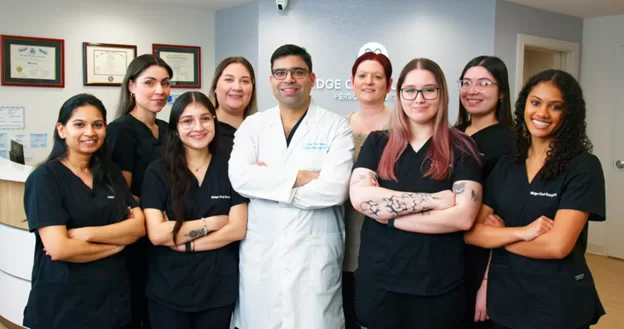Picture this: You’ve just undergone a tooth extraction, and instead of anticipating weeks of sore gums and avoiding your favorite foods, you find yourself crunching down on apples within a few days. Sound far-fetched? Welcome to platelet-rich fibrin (PRF), the new champion of modern oral surgery.
PRF is a groundbreaking treatment that brings your body’s own healing properties to bear to shorten recovery times and complications, and offer outcomes that other modalities cannot match. In fact, research suggests that there is up to a 50% higher rate of tissue regeneration with PRF versus traditional healing techniques14. Let’s take a look at why PRF is more than a recent trend- it is the future of dental treatment.
Understanding PRF: A Natural Approach to Healing
Your blood is a huge source of healing agents, and PRF allows you to utilize the full power of your own blood. Here’s how it works: a small sample of blood is drawn from your arm and then placed in a centrifuge to isolate the platelet-rich fibrin, which is a gel-like substance composed of growth factors, white blood cells, and a fibrin matrix.
Unlike platelet-rich plasma (PRP), which requires additives and only releases the growth factors for a short amount of time, PRF is 100% natural and slowly releases the healing agents over the course of 7–14 days. You can think of PRF as a slow-drip IV of repair cells, while PRP is more of a one-time experience. The gradual delivery of the healing agents makes PRF the ideal choice in complex procedures such as dental implants or bone grafts, where long-term healing is critical.
The Benefits of PRF in Oral Surgery
Why are surgeons excited about PRF? Let’s talk about it:
- Quicker Healing: PRF is like a “turbo button” for tissue healing. By enhancing the concentration of growth factors, PRF encourages cell regeneration that sometimes helps speed up recovery by over 50%, with patients reporting less swelling and increased speed of return to normal diets.
- Infection Fighter: Because of the abundant white blood cells in PRF, PRF acts like a bouncer for bacteria; lower infection rates after surgery are expected when utilizing PRF. Say goodbye to worrying about dry sockets after tooth extractions!
- No Synthetic Stuff: Since PRF is derived from your own blood, there is zero risk for rejection or allergy. It’s like giving your body a blueprint to rebuild itself.
- Cost Effective: Fewer complications after surgery mean fewer visits for follow-up. Saving money on regenerative synthetic grafts is also part of the cost benefits.
How is PRF used in Oral Surgery?

PRF is versatile. Here’s where it works best:-
- Tooth Extractions: PRF plugs the socket like a biological Band-Aid and protects the area from food debris and bacteria. It reduces the risk of dry socket by 70%, according to research.
- Dental Implants: Placed around titanium posts, PRF enhances osseointegration (the bond between implant and jawbone). This is due to the improvement of bone density, PRF provides bone support.
- Gum Grafts: PRF combined with graft material provides a “scaffold” for new tissue and tissue regeneration when treating receding gums, where PLF is incredibly effective.
- Sinus Lifts and Bone Grafts: By adding PRF or placing PRF in underdeveloped and “flimsy” bone structures, PRF will create a more solid foundation for implants by providing support to weak areas.
What to Expect During a PRF Treatment?
No complicated machines or scalpels—just three easy steps:
1. Blood Draw: We take 1-2 tablespoons of blood from your arm (less than a lab test!)
2. Spin Cycle: The blood is spun for 10 minutes to separate the PRF from red blood corpuscles.
3. Application: The PRF gel is placed into the surgical site. For an implant, we will often layer the PRF around the post to prepare the area for bone generation.
Recovery? Most patients will need 3 to 5 days of mild recovery as opposed to 2 weeks with traditional methods.
PRF vs. Traditional Healing Methods: Why It’s the Better Choice
Platelet-Rich Fibrin (PRF) provides considerable superiority to synthetic grafts and sutures in conventional use in oral surgery. Contrary to the synthetic materials, PRF is created from the patient’s blood, eliminating any danger of rejection and infection. With its natural nature, tissue growth occurs rapidly, which brings faster recovery rates and better outcomes for oral health.
Research has indicated that PRF may be as efficient as connective tissue grafts in root coverage and gingival attachment enhancement. Furthermore, PRF’s affordability is due to its capacity to reduce the number of additional surgeries needed and healing time, ultimately decreasing the overall costs of treatment.
The patients also indicate increased satisfaction as a result of the minimally invasive nature of PRF and the comfort that comes with utilizing the body’s own healing properties. For an implant, PRF improves the probability of integration, decreasing the risk of failure by 30 percent.
Common Myths & Misconceptions About PRF
Despite its growing popularity, Platelet-Rich Fibrin (PRF) is still surrounded by a few common myths. Let’s clarify what PRF truly offers in dental care.
Is PRF safe?
Yes, PRF is very safe since it is 100% natural, using the patient’s own blood to produce a fibrin matrix with high platelet and growth factor content. This autologous method prevents allergic reactions or disease transmission, thus making it a safe option in dental treatment.
Does PRF hurt?
No, the PRF procedure is a brief one and painless in most cases. It involves taking a small quantity of the patient’s blood, which is then centrifuged to isolate the PRF. It is then placed on the surgical site to facilitate healing. Patients bear little or no pain following and during the procedure.
Is PRF only for major surgeries?
No, PRF is not limited to major surgeries and can be used to improve recovery in other dental procedures as well. It is successfully applied in procedures like tooth extractions, implant placement, and periodontal treatment to facilitate quicker healing and minimize complications.
Why Choose Ridge Oral Surgery for PRF Treatment?
Here at Ridge Oral Surgery, our team of skilled oral surgeons has the expertise and experience needed to provide advanced healing procedures such as Platelet-Rich Fibrin (PRF) applications. We strive to incorporate the latest technology to achieve accurate and efficient treatments that address every patient’s unique needs. Our patient-oriented policies emphasize comfort, safety, and optimal outcomes. With a successful history of implementing PRF in different oral surgeries, we accelerate healing processes and increase overall patient satisfaction.
Rely on Ridge Oral Surgery to offer you superior care and innovative solutions for your oral care needs. Want to See the Results for Yourself? Explore our PRF-driven implant success stories.
FAQs About PRF in Oral Surgery
Q: How long until I’m healed?
A: Most patients feel normal within a week, though full bone regeneration takes 3–6 months.
Q: Can PRF be used with bone grafts?
A: Absolutely! PRF mixed with graft material enhances stability and speeds up fusion.
Q: Will insurance cover PRF?
A: Coverage varies, but many plans partially reimburse it as an “advanced healing aid.”
Schedule a Consultation to Experience the Benefits of PRF

Initial application of Platelet-Rich Fibrin (PRF) can greatly promote the healing results of dental procedures. Through the application of PRF, patients typically have less postoperative pain and faster tissue recovery. Research has shown that the treatment with PRF results in improved wound healing, as characterized by decreased scores of pain and enhanced healing indexes in comparison with conventional treatments.
At Ridge Oral Surgery, our staff is committed to delivering advanced, patient-focused care. We encourage you to schedule a consultation to discuss how PRF can enhance your oral health. Reach out to us or visit our website to arrange an appointment. Taking this active step can result in enhanced healing and satisfaction with your dental procedure.
